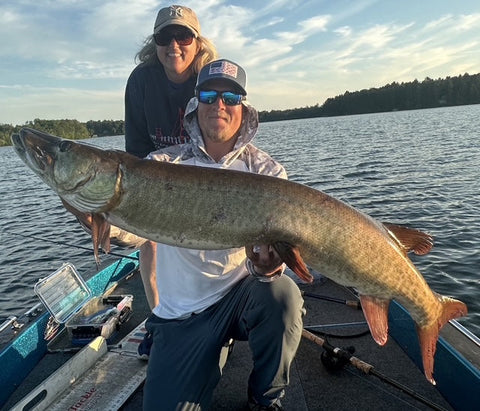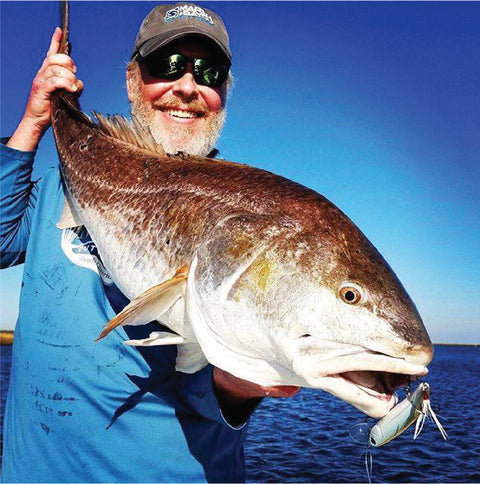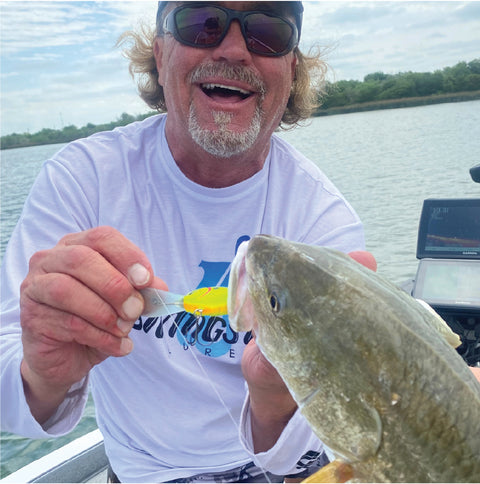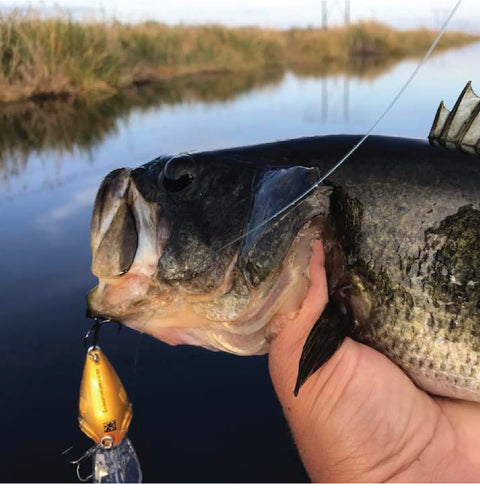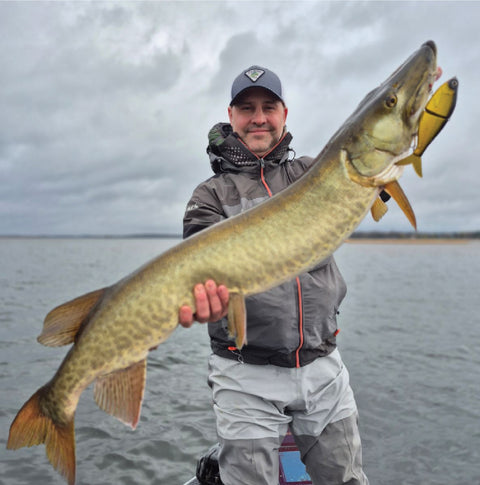Ohio Muskie Fishing: Ultimate Guide to Catching Trophy Muskies

Ohio muskie fishing is a bucket-list adventure for anglers chasing the thrill of landing a trophy fish. Known as the "fish of 10,000 casts," Ohio’s pure strain muskies deliver explosive strikes and unforgettable battles. This guide, featuring expert tips from Livingston Lures Pro Staff member Steve Herbeck, reveals the best lures, prime locations, and proven techniques to hook Ohio’s elusive muskellunge. Whether you’re a seasoned muskie hunter or just getting started, here’s everything you need to know to conquer Ohio’s waters.
Why Ohio Muskie Fishing Stands Out
Ohio’s muskie fisheries are known for their quality and diversity. The state’s lakes and reservoirs are stocked with pure strain muskies prized for their size, strength, and cunning behavior. As Steve Herbeck puts it, “Ohio muskies have a unique rhythm. They’re aggressive yet cautious, requiring precise lure selection and a deep understanding of their habitat.” With the right approach, you can target these apex predators and experience some of the best muskie fishing in the Midwest.
Understanding Muskie Habitat in Ohio
Muskies are ambush predators that favor structure-rich areas to hide and strike:
-
Vegetation: Cabbage and milfoil beds are prime ambush points. Steve notes, “Muskies lurk along milfoil edges, waiting for prey.” Lily pads offer overhead cover during summer.
-
Wood: Fallen trees, stumps, and flooded timber attract baitfish and provide shade. Standing timber is especially productive in colder months.
-
Rock: Riprap, boulders, and rocky breaklines retain heat and attract forage, making them year-round hotspots.
Focus on wind-blown banks, hard-to-soft bottom transitions, and current seams in reservoirs for best results.
Top Lures for Ohio Muskie Fishing
Choosing the right lure is critical. These proven baits come highly recommended by Steve and the Livingston Lures team:
-
Titan: Dive-and-rise action lure, great for shallow cover or transition zones.
-
Big Makk: Loud topwater prop bait, ideal for low-light or surface-feeding muskies.
-
Kraken: Large tube bait with erratic fall, perfect for pitching into isolated cover.
Optimal Water Temperatures for Ohio Muskies
Muskies feed most aggressively within certain temperature ranges:
-
Low 50s to mid-70s °F: Peak feeding activity; “mid-60s is the sweet spot for Ohio muskies,” says Steve.
-
Above 78°F: Muskies move deeper or suspend near structure.
-
50–79°F: Muskies may feed shallow, from near the surface to mid-water column in deep lakes. Water Temperatures in the 80's should be avoided for the health and safety of Ohio Muskies.
Trolling Techniques for Ohio Muskies
Trolling is essential for covering large reservoirs and lakes:
-
Keep lures in the strike zone—above weed tops, along breaklines, or near points and humps.
-
Muskies often follow before striking, so long trolling runs increase your chances.
Livingston Lures Blade Planer Boards let you run multiple lures far off the boat, covering more water without spooking fish. Pair planer boards with lures like Magnus or Squeaky Pete to reach deep strike zones.
Target open water near points, breaklines, and subsurface humps. Hit humps repeatedly to coax reaction strikes.
Trolling speeds:
-
Colder water (50s): 2–3 mph
-
Warmer water (70s): 3.5–5 mph
“Watch baitfish and adjust your speed until you trigger a bite,” advises Steve.
Handling and Releasing Muskies
Muskies require careful handling to ensure survival:
-
Use a rubber mesh net and keep the fish wet.
-
Support the fish’s body fully and avoid touching gills or eyes.
-
Quick releases help protect this prized sport fish for future anglers.
Expert Tips for Ohio Muskie Success
-
Fish early and late when muskies feed shallow in low-light conditions.
-
Match local forage by selecting lures that mimic shad or perch.
-
Vary your retrieve with steady pulls, pauses, or twitches to trigger strikes.
-
Use heavy rods, strong reels, and 80–100 lb fluorocarbon leaders.
-
Stay persistent; muskies demand patience and consistent effort.
Best Locations for Muskie Fishing in Ohio
-
Ohio ranks among the Midwest’s premier muskie fishing destinations. Thanks to an extensive stocking program by the Ohio Department of Natural Resources (ODNR), the state’s reservoirs and impoundments consistently produce fish exceeding 40 inches, with the occasional 50-incher surfacing each season. Below is a refined list of Ohio’s top muskie waters, reflecting the latest ODNR data and angler reports.
Top-Tier Muskie Waters (ODNR Stocked and Proven Producers)
Alum Creek Musky Fishing
Located in Delaware County, Alum Creek is one of Ohio’s top muskie lakes and among the most consistent trophy producers. Its combination of deep points, submerged timber, and expansive weedlines offers ideal muskie structure. Anglers troll or cast crankbaits and jerkbaits along main-lake points and timbered coves. Fish over 48 inches are caught each season, with the best action from late spring through early fall.Clear Fork Reservoir Fishing
Near Mansfield, Clear Fork is legendary among Ohio muskie anglers. It features healthy vegetation, wood cover, and a strong forage base that supports both numbers and size. This lake consistently ranks high in ODNR’s muskie angler logbook, and fish exceeding 50 inches are reported annually. Casting large glide baits, crankbaits, and topwaters over submerged weed beds is highly effective from late May through October.Leesville Lake Musky Fishing
Leesville in Carroll County remains one of Ohio’s most storied muskie fisheries. Known for its clear water and steep-sided valleys, it produces quality fish in both numbers and size. Most anglers focus on trolling crankbaits and spinnerbaits along the main channels and drop-offs. Spring and early summer are prime, especially near the lower basin and dam area.Salt Fork Lake Musky Fishing
Southeast Ohio’s Salt Fork is the state’s largest inland reservoir and a consistent producer of muskies. The lake offers a mix of timber, creek arms, and deep water, supporting a balanced muskie population. Anglers find success trolling large plugs in 10 to 20 feet of water or casting jerkbaits and swimbaits along weed edges and points during early morning or evening hours.Caesar Creek Lake Musky Fishing
Located in southwestern Ohio, Caesar Creek has become a solid muskie destination since ODNR began stocking it regularly. The lake’s deep water and rocky points favor trolling patterns with large crankbaits, while spring casting near flooded timber and coves can yield fish in the upper 40-inch class. Late fall trolling along the dam face and mid-lake humps is particularly productive.Secondary and Incidental Muskie Waters
Pymatuning Reservoir Musky Fishing
Shared by Ohio and Pennsylvania, Pymatuning holds muskies but at lower densities than the dedicated ODNR lakes. Anglers trolling open-water breaks in 10 to 20 feet occasionally connect with solid fish, particularly in fall. The Pennsylvania side generally receives more attention and higher catch rates.Western Basin of Lake Erie Musky Fishing
While not a managed muskie fishery, the western basin occasionally produces large, naturally occurring muskies. Most encounters occur near the Bass Islands and reef complexes while trolling for other species. Catches are rare but can exceed 50 inches.Berlin Lake Musky Fishing
Berlin Lake offers some potential for incidental muskies in deeper structure and river inflows, but it is not part of ODNR’s primary stocking program. Anglers targeting other species occasionally hook muskies near rocky points and current seams.Indian Lake Musky Fishing
Indian Lake supports occasional muskie catches, often early in the season near weed beds and shallow humps. It is not a major stocked site, so expectations should remain modest.Mosquito Creek Lake Musky Fishing
Muskies are present but in low density. Anglers trolling the eastern shoreline drop-offs have a chance at incidental fish, particularly during the warm months.Grand Lake St. Marys Musky Fishing
This large, shallow lake occasionally produces muskies, though the population is sparse. Focus efforts on vegetated bays and weed edges in spring if targeting them specifically.
Each location offers diverse habitats, ensuring opportunities for every angler.
-
Ohio Muskie Fishing Frequently Asked Questions (FAQ)
Q: What are the best lakes for muskie fishing in Ohio?
A: Top Ohio muskie lakes include Indian Lake, Alum Creek Lake, Buckeye Lake, Pymatuning Reservoir, and the Western Basin of Lake Erie.
Q: What lures work best for Ohio muskies?
A: Effective lures include the Livingston Lures Magnus,Titan, Big Makk, smaller crankbaits are also popular.
Q: When is the best time to fish for muskies in Ohio?
A: Muskies are most active early and late in the day, especially during spring and fall when water temperatures range from the low 50s to mid-70s °F.
Q: How should I handle and release muskies?
A: Use a rubber mesh net, keep the fish wet, support its body fully, avoid touching gills or eyes, and release quickly to ensure survival.


